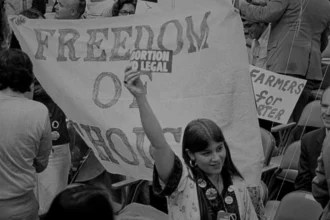The debate over “gender ideology” has become a central issue in contemporary socio-political discourse, marking a significant point of contention between progressive movements and conservative forces. Initially emerging from Catholic teachings, this concept has grown beyond its ecclesiastical roots to become a key issue for conservative groups worldwide.
Driven by concerns over the encroachment of what they perceive as radical views on gender and sexuality, these factions, led notably by the Vatican, have mobilized to counteract the growing acceptance and legal recognition of Sexual and Reproductive Rights (SRR).
This resistance is framed as a defense of traditional values against the backdrop of Universal Human Rights, positioning “gender ideology” as a pivotal battlefield in the wider struggle over moral and cultural norms. This mobilization not only reflects a deep-seated ideological divide but also underscores the complex interplay between religion, politics, and the evolving landscape of human rights.
The Origins: A Vatican Strategy
At the close of the 20th century, the escalating legal and cultural acknowledgment of sexuality and reproduction, spearheaded by feminist and LGBTQI movements, marked a significant departure from the Catholic Church’s traditional moral doctrines, especially those concerning the natural law of sexuality. The Vatican and pro-life activists, in response to these progressive ideologies, strategically coined the term “gender ideology” as a countermeasure.
The Vatican’s introduction of “gender ideology” into global discourse aimed to equip conservatives with the means to challenge the progress of gender and sexual rights.
The term “gender ideology” was crafted with the intention of challenging and undermining the growing influence of feminist and LGBTQI movements. It aimed to portray their advocacies as threats to a universally accepted framework of sexual morality. By considering gender as an ideology, the aim was to underscore the perceived falsity of the positions and demands put forth by these groups.
The Vatican’s adoption of this term was a proactive maneuver aimed at safeguarding and promoting its doctrinal views amidst shifting social currents. This strategic move formed part of a broader effort to reinforce traditional moral values in response to perceived encroachments on societal norms regarding gender and sexuality.
By introducing “gender ideology” into the global discourse, the Vatican sought to mobilize conservative forces, equipping them with a lexicon to resist and critique the advancements made by gender and sexual rights movements. This strategic choice reflects the Church’s long-standing commitment to influencing moral and cultural conversations on a global scale, emphasizing the perceived dichotomy between traditional moral values and the progressive ideals championed by feminist and LGBTQI movements. Through this lens, the Church positioned itself as a bulwark against the erosion of traditional values, endeavoring to stem the tide of legal and cultural shifts that it viewed as antithetical to its moral teachings.
Latin America: A Neoconservative Battleground
In Latin America, the discourse surrounding “gender ideology” has not only gained traction but has also become a focal point around which a new neoconservative movement has emerged. This movement goes beyond traditional conservatism, representing a calculated and multifaceted reaction to the progress advocated by SRR activism. It symbolizes a wider and deeper cultural and legal resistance against what is perceived as progressive ideologies encroaching upon traditional societal norms.
This influence extends beyond the Catholic sphere, as conservative factions within the Catholic Church and radical right-wing politicians in numerous countries have begun to embrace it. This neoconservative crusade in Latin America is characterized by its multifaceted approach, involving a broad coalition of actors including religious hierarchies, secular politicians, and civil society groups. Together, they frame “gender ideology” as an existential threat to the foundational pillars of society: the family, sexual norms, and national identity. This concerted effort aims not only to counter the legal and cultural gains made by SRR movements but also to reassert a moral and legal order that aligns with conservative values.
The mobilization of law and culture against “gender ideology” is a dynamic and adaptive strategy.
The strategic deployment of “gender ideology” as a rhetorical and political tool reflects a deeper ideological and moral battle. Neoconservative actors utilize this concept to mobilize support, arguing that the acceptance and institutionalization of progressive gender and sexual rights norms undermine traditional values and societal stability.
By advocating for the re-moralization of laws surrounding sexuality, these groups seek to preserve a specific vision of social order that privileges traditional family structures and heteronormative sexual norms. Furthermore, the movement’s emphasis on national sovereignty touches upon concerns regarding external influences—particularly from international human rights organizations and foreign governments—on domestic social policies. Neoconservatives argue that the global push for SRR represents an imposition of foreign values on Latin American cultures, thus framing their opposition as a defense of national identity and autonomy.
The neoconservative response to “gender ideology” in Latin America is an active effort to reshape the region’s moral and legal landscape. This initiative reflects a broader global contestation over the future direction of gender and sexuality rights, situating Latin America as a critical battleground in the ongoing struggle between progressive ideals and conservative resurgence.
The Mobilization of Law and Culture
The mobilization of law and culture in the face of “gender ideology” represents a multifaceted strategy by the neoconservative movement, aiming to safeguard traditional values against the perceived encroachments of modern gender norms. This effort transcends mere doctrinal opposition, evolving into a comprehensive cultural and political campaign designed to challenge and resist the growing acceptance of diverse sexual and reproductive rights. By strategically leveraging legal frameworks, these actors aim to curtail the influence of progressive ideologies, asserting a conservative moral vision over societal norms and legal standards.
The discourse on “gender ideology” reveals a critical tension within modern democracies.
This legal mobilization is characterized by a concerted effort to engage with and influence the legal system, utilizing litigation, advocacy, and legislative processes to oppose policies that recognize or promote gender diversity and equality. This approach is part of a broader endeavor that includes educational campaigns, media outreach, and public demonstrations, aiming to shift public opinion and cultural attitudes towards a more conservative stance on gender and sexuality.
Furthermore, this movement seeks to redefine the cultural landscape by framing the discourse around gender and sexuality as a moral crisis that threatens the social fabric. In doing so, the new conservative alliance positions itself as the defender of societal stability, employing a narrative that resonates with broader segments of the population who may fear the rapid pace of social change.
The mobilization of law and culture against “gender ideology” is a dynamic and adaptive strategy that reflects a deep engagement with the mechanisms of power and influence in society. Through legal action, cultural engagement, and political advocacy, these actors strive to maintain a conservative grip on the definition and regulation of gender and sexuality, aiming to shape the moral and legal contours of contemporary society.
Conclusion: Implications of the Fight Against “Gender Ideology”
The discourse on “gender ideology” reveals a critical tension within modern democracies, highlighting the clash between progressive gender and sexuality norms and traditional conservative values.
This battle extends across various domains—legal, cultural, and political—significantly influencing the dialogue surrounding rights, identity, and the core principles of democratic societies. This article has delved into the conservative mobilization against “gender ideology,” underscoring its origins, methods, and potential ramifications.
As societies grapple with these divisive debates, the discourse is inevitably shaped by the ongoing interplay between traditional values and progressive ideals. This dynamic tension reflects a perpetual quest for equality and inclusiveness, hinting at a future where the interplay of these opposing forces will define the course of democratic dialogue and decision-making, shaping societies’ capacity for inclusivity and fairness.
This analysis adapts for a broader audience the perspectives and findings of the author, as presented in ‘The conservative uses of law: The Catholic mobilization against gender ideology’.









